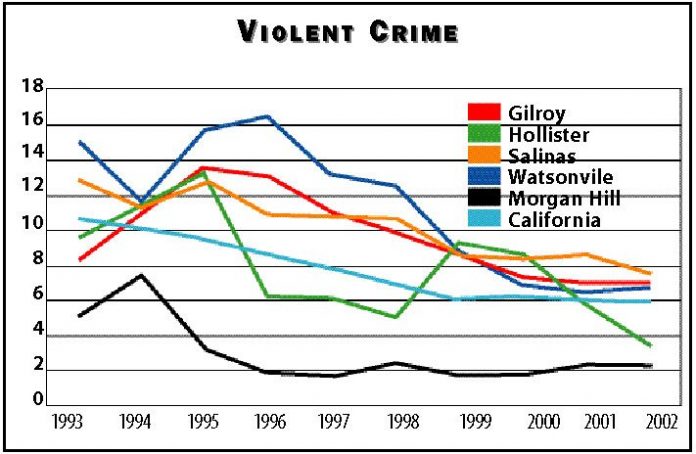GILROY
– In general, there is less crime in this city than there was 10
years ago. The growth of the Gilroy Police Department – especially
the advent of the gang-specialist Anti-Crime Team – has a lot to do
with that decline, police say.
GILROY – In general, there is less crime in this city than there was 10 years ago. The growth of the Gilroy Police Department – especially the advent of the gang-specialist Anti-Crime Team – has a lot to do with that decline, police say.
A recent Santa Clara County report that showed Gilroy having a high rate of aggravated assault and other types of violent crime compared to other county cities was “just a snapshot,” according to Police Chief Gregg Giusiana. It doesn’t show the progress this city has made in public safety over the last decade, the chief said.
According to GPD statistics released Friday, the rate per capita of Part One crime – which consists of both violent crimes and crimes against property – decreased 40 percent in Gilroy from 1993 to 2002.
Violent crime – homicide, forcible rape, robbery and aggravated assault – was down 13 percent from 1993 to 2002 and down 50 percent from a peak in 1995. Aggravated assaults, in particular, have dropped 58 percent since 1995, but Gilroy still has more per capita than Salinas, Watsonville, Hollister, any other Santa Clara County city or California or the United States as a whole. Rape cases, which had risen since 1999, dropped off massively so far this year.
Property crime – burglary, general theft, auto theft and arson – shows a substantial slide; it has dropped 43 percent in the past decade. The tide may be turning back, however; auto theft, burglary and general theft counts have risen so far this year over 2002.
While the statistics show improvement in public safety, the reality is even better, Giusiana says. The stats only show reported crimes, but the GPD of 1993 wasn’t on top of the city’s gangs enough to report as many crimes as they do now. Back then, it could take the GPD 10 minutes to respond to a gang fight, and those involved would often be gone by the time officers showed up. The ACT’s coming-of-age in 1995 put a lot of pressure on gangs, and these enforcement caused a peak in reported violent crime – crime that had been happening before but which the GPD couldn’t react to quickly enough, Giusiana said. Since 1995, the crime rate has dropped.
According to ACT Sgt. Greg Flippo, the gangs are still there, but most of their leaders are incarcerated. There’s been an increase in activity over the last two months, but there’s still little action. Lately, the ACT has been able to wrap up some cases within a few days.
“That’s because of the expertise of the team,” Flippo said. “You not only know the gang member; you know his family, you know his brothers and sisters, you know his girlfriend.”
The ACT spends much of its time these days checking up on known gang members. Many are on parole or probation and are therefore subject to searches for drugs and weapons at any time, at the officers’ discretion. On one day two weeks ago, police searched 17 homes and made nine arrests.
The ACT is only one new arm of a stronger GPD that has outgrown its Rosanna Street headquarters, and the transition has cost taxpayers millions of dollars. Police and fire services currently make up 80 percent of the city’s general fund budget, and the GPD is pushing for a new, larger headquarters that is expected to cost about $20 million.
Nevertheless, the greater pressure local police are now able to put on criminals is not something to be compromised for budgetary concerns, Mayor Tom Springer – soon to leave office – said at a Friday meeting of the City Council, GPD and Gilroy Fire Department.
“It takes years to build a building and moments to tear it down,” Springer said. “It takes moments to let up (the GPD’s pressure on crime) but years to recover.”
City Councilman and Mayor-elect Al Pinheiro said it has been “a long haul” to get the GPD to a target ratio of 1.5 officers per 1,000 residents, and while the city is “going in the right track” in terms of police protection, “there’s going to be lots of challenges over the next month as we look at this budget.”
Pinheiro asked police Friday to examine their own programs to see where cuts could happen.
“Where are the things that are a must to prevent crime and deter crime, and where are the things that are nice to have in good budget times … but can be dispensable?” Pinheiro told The Dispatch later.
Pinheiro said he doesn’t have a sense yet what to cut and what not to, and he’s looking to police – or, as he says, “the professionals” – for answers.
Gilroy crime facts:
• There has been one homicide so far in 2003. There were none in 2002.
• There were seven rape cases from Jan. 1 to Oct. 1 this year, down 70 percent over the same time period in 2002. Of these seven, six had been solved. In 2002, Gilroy had a rate of rape per capita much higher than the state average or the rates in Watsonville, Hollister, Salinas and Morgan Hill.
• To address the increase in rape in recent years, the GPD added a second detective to its sex-crimes investigation team this year.
• Robberies in 2003 were down 30 percent as of Oct. 1, compared to 2002. Gilroy’s robbery rate rose from 2000 to 2002 but was still below the state average. Salinas, for example, has significantly more per capita.
• While the number of aggravated assaults so far this year is on track with 2002, simple assaults were down 41 percent as of Oct. 1 over the same time period (Jan. 1 to Oct. 1) in 2002: 162 in 2003 compared to 276 in 2002.
• There were 142 auto burglaries from Jan. 1 to Oct. 1, 2003, up 42 percent from 100 in the same months of 2002.
• There were 164 burglaries from Jan. 1 to Oct. 1, 2003, up 37 percent from 120 in the same months of 2002.
• There were 899 general thefts from Jan. 1 to Oct. 1, 2003, up 14 percent from 792 in the same months of 2002.













